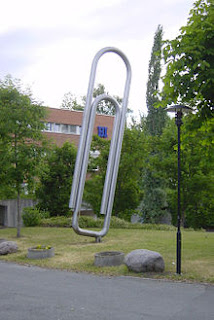 |
| Image by David Masters via Flickr |
The paperclip's history begins with the first patent being
awarded to Samuel B. Fay in the United States in 1867. That design was intended to attach
labels to garments and fabric. Just
10 years later, in 1877, Erlman J. Wright patented the first version explicitly
intended to clip sheets of paper together. But neither of these patents were for the design we know of
as the Gem paperclip. That design
was never patented, which contributes to a long-standing myth that the first
paperclip was invented and produced in Norway. Norwegian Johan Vaaler patented his design in both Germany
and the United States in 1901.
The
myth of the Norwegian origin of the paperclip really gained ground after World
War II. When the Germans
prohibited wearing pins including the Norwegian flag or insignias or
portraits of the king, the Norwegians began to wear paperclips on their lapels
as a symbol of their solidarity against the Nazis.
 |
| Sandvika Norway paper clip via Wikipedia |
In
1998, the myth of the Norwegian origin of the paperclip was still prevalent,
along with the embellishment which transformed the tale of the lapel paperclip from
a symbol of resistance against the Nazis to a symbol of solidarity with the
Jews. When students at Whitwell
Middle School in Whitwell, TN, asked their teacher if they could collect
something as part of their unit on the Holocaust to get a concrete idea of just
how big the number six million is, they discovered the paperclip’s myths and
set the goal of collecting six million.
By
2001, the eighth graders had collected not six, but 30 million paper clips. They had received and cataloged 30,000
letters about their project. And they
had received a donation of a box car that had been used to transport Jews,
gypsies, and others considered undesirable by the Nazis, to concentration
camps. Transporting the box car
included crossing the Atlantic on the chartered Norwegian freighter “MS Blue
Sky,” continuing the myth of the Norwegian connection. The box car now forms the centerpiece
of the Children’s Holocaust Memorial.
The documentary “Paper Clips” retells the whole story.
A
footnote, related to World War II but not included in the Whitwell Middle
School Paper Clip Project, is that another post-World War II effort, code-named
“Project Paperclip,” resulted in the immigration of more than 700 German
scientists into the United States, including Werner von Braun and 125 rocket
scientists who contributed significantly to the development of the NASA space
program in the 1950s and 1960s.
 |
| Image by kylemac via Flickr |
The
trade that propelled the bartering to a higher level for Kyle was the
opportunity to spend half a day with Alice Cooper. And the trivia highlight for me in all of this is that
before moving to his next trade, Kyle was asked to join Cooper on tour in – of all places – Fargo, ND.
As
I think back to that Table Topics exercise, I can’t recall a more imaginative
response than the actual story I discovered through research about the humble
paperclip. I hope that I have
provided you with some entertainment, along with the lesson that there is no
subject is too humble to be considered as a topic of a Toastmasters speech.

I studied this blog about Paper Clips and it's history. Nice............
ReplyDelete